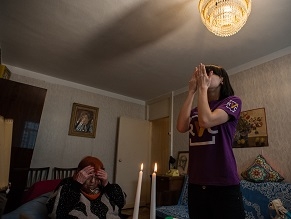|
Euroasian Jewish News

A young Jewish volunteer in Chisinau, Moldova, celebrates Shabbat traditions with Ira G, a homebound senior suffering medical issues. Credit: Arik Shraga for JDC
|
Hanukkah, in all its light, rises among post-Soviet Jewry
05.12.2018, Community Life Thirty-one years ago on Dec. 6, on what came to be called “Freedom Sunday,” hundreds of thousands gathered in Washington to protest the Soviet regime’s relentless discrimination against Jews. The Communists thwarted their professional ambitions, discouraged religious observance and barred Jews from leaving.
Not long after President Ronald Reagan urged the Soviets to “tear down this wall,” the Soviet regime finally relented, allowing more than 1.5 million Jews to leave for Israel, Western Europe and the United States. This wave of immigration spawned countless success stories—from the founding of Google and WhatsApp to distinguished service in the Israeli government.
Perhaps because this modern-day exodus was so compelling, it has obscured a less well-known story: the tragedies and triumphs of Jews who did not leave. Today, there are almost 1 million Jews in Russia, Ukraine and other post-Soviet states.
The elderly among them remember the devastation of World War II. More than 40,000 survived the Holocaust. All lived through decades of Soviet repression, struggling to survive and often concealing their Jewish identities.
As if that was not enough, today tens of thousands face grinding poverty. Although many were professionally successful, even retired engineers, doctors and teachers have government pensions as low as $2 per day, which don’t cover the basic necessities of life.
They’re haunted by memories of loved ones lost years ago. Maya, a woman I met in Belarus, lives steps away from the place where, as a young girl, she found her mother’s body, murdered by the Nazis and hanging from a lamp post. Abe also remained in Belarus, living near the site where his childhood home was leveled by a German bomb.
Tens of thousands of Jews in their generation suffer from crushing loneliness. Because their living relatives left decades ago, these elderly Jews have no one to help them through the region’s cold, dark winter.
In response, my organization provides almost 100,000 of these Jewish seniors with life-saving care. In partnership with the Claims Conference, the International Fellowship of Christians and Jews, Jewish Federations and other partners, we are spending $115 million on food, medicine, winter relief, socialization and home care for these long-suffering seniors.
In the coming decade, this historic humanitarian aid program faces a significant challenge: the end of Holocaust restitution. Currently, restitution funds cover almost 80 percent of the program’s budget, but this funding is available only for Holocaust survivors. As more survivors pass away, restitution funding will decline and eventually no longer be available.
Since thousands of elderly Jews who are not survivors will still need life-saving care, we have launched a fundraising effort to raise an additional $25 million over the next five years. To do that, we are spreading the word about these brave people, their histories and the wisdom they offer to the generations of Jews who follow them.
These rising generations represent the uplifting part of the story. Although Jewish life came perilously close to extinction in the region, they are reviving it.
Not so long ago, elderly Jews were keepers of Jewish values and traditions banned in the USSR since they could remember life before the Russian Revolution. But today, thousands of young people are embracing their Jewish identities. They see Judaism as cosmopolitan, global and even “cool.”
For example, we launched a teen program, called “Active Jewish Teens,” which started five years ago with 30 teens in Kharkov, Ukraine. Today, the group has 3,100 members in almost 60 cities throughout the region, who are connecting with their Jewish heritage and serving as Jewish role models for their families and communities. Through its affiliation with BBYO, the pluralistic teen movement, AJT teens and their American peers learn from one another about their Jewish experiences and forge bonds that strengthen Jewish communities in both places.
There’s also a burgeoning renaissance of civic commitment and volunteerism among Jews. Ironically, these values withered during the Soviet era, even though the system purported to rest on the ideal of “each according to his ability, each according to his need.” But daily life in the USSR was in ways more Hobbesian than communitarian. Everyone knew they were on their own in navigating a Kafkaesque system and looked for any personal advantage they could find.
But today, thousands of Jews of all ages are volunteering to help the less fortunate. Through volunteer centers, which are supported by the Genesis Philanthropy Group, a global foundation focused on Russian-speaking Jewry, we’ve deployed thousands of Jewish volunteers, who just this year aided 40,000 people. Scores of Jewish Community Centers and leadership-training programs reinforces this promising trend.
The exodus of Jews from the Soviet Union reminds us of the Jewish holiday of Passover, when Moses urged Pharaoh to “let my people go.” But the experience of those who stayed is reminiscent of a different Jewish holiday, Hanukkah, which we celebrate this week.
We’ll recall an ancient Jewish victory, defeating a tyranny that was bent on destroying Jewish life. We also remember a tiny cask of oil that against all odds enabled the menorah in the Jewish temple to burn bright for eight days. It is customary to proclaim nes gadol hayah sham: “A great miracle happened there.”
Today, we should celebrate the modern miracles happening among Jews of the former Soviet Union and remember the power of light to overcome darkness. With every food package we deliver, with every volunteer who helps her neighbor and with every Hanukkah prayer that is said from Moscow to Tashkent, the flame burns brighter.
By David Schizer
David M. Schizer is CEO of the American Jewish Joint Distribution Committee.
JNS
|
|
